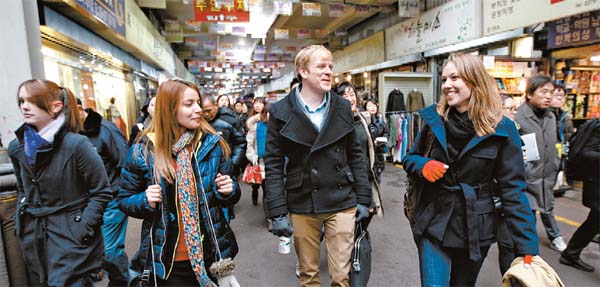Interns reveal impressions of Seoul

Sabrina Meyer, right, a German participant in the Seoul Metropolitan Government’s global internship program, checks out Gwangjang Market in Jongno District, central Seoul, with her colleagues on Feb. 6. By Kim Seong-ryong
Since Jan. 4, 37 people from 16 countries have been participating in the program, which the Seoul Metropolitan Government has been offering every summer and winter vacation since 2008. The interns are placed in different city government departments and work there for seven weeks. They also participate in cultural events.
The hottest topic of discussion in the interview wasn’t Gangnam, despite the influence of Psy’s hit song, and it wasn’t cultural assets like Gyeongbok Palace. It was Seoul’s subway system.
Abraham, a 40-year-old from Senegal, gave the metro the thumbs up. “I was able to go pretty much everywhere via subway because it has many lines and they’re connected to each other,” he said. “It was amazing that they don’t charge extra fees when you transfer to a different line.”
Other people from both Asia and Europe had similar impressions. “I think my country could adopt Seoul’s mass transportation system,” said a 26-year-old woman from Poland.
But the impressions weren’t all positive. Among pet peeves were drunks and religious zealots who sometimes harass commuters.
“It really was a scary moment,” said a 23-year-old woman from Iran. “Sometimes strangers abruptly approached me and told me to convert to a religion. In evening hours, many drunken passengers also acted weirdly.”
“I never had such religion-related unpleasant experiences in my home country,” said Jin, 29, from China. “People around me have experienced the same thing and none of them want to remember that moment.”
“When a train stops, the doors become like a public marketplace because everyone rushes toward the doors very quickly,” said Kato Kana, 23, from Japan. “I was scared of getting hit against the wall of the train when people behind pushed me so hard.”
Some were shocked by the number of ads for plastic surgery clinics on the trains and in the stations.
And the “Gangnam Style” sensation couldn’t compensate for some firsthand impressions of the neighborhood.
“When I see people in Gangnam, they look fancy and stylish,” said Sabrina Meyer, a 24-year-old from Germany. “But when I looked at them, I felt like many of them are just showing off their wealth.”
“Gangnam doesn’t have its own magnetism,” said Kato. “It’s a place that just has more expensive imported cars and higher market prices than other areas. When I visited Dongdaemun I was surprised by the economic gap between the two areas. It clearly showed the gap in the standard of living in the city.”
Some also said Koreans have some things to learn about work-life balance. “I saw Korean officials often work late into the evening, and some of them came to work even on the weekends,” said Meyer. “People in Germany generally leave the office at 5 p.m. to spend time with their families.”
By Kang Na-hyun, Cho Han-dae [sakwon80@joongang.co.kr]










with the Korea JoongAng Daily
To write comments, please log in to one of the accounts.
Standards Board Policy (0/250자)